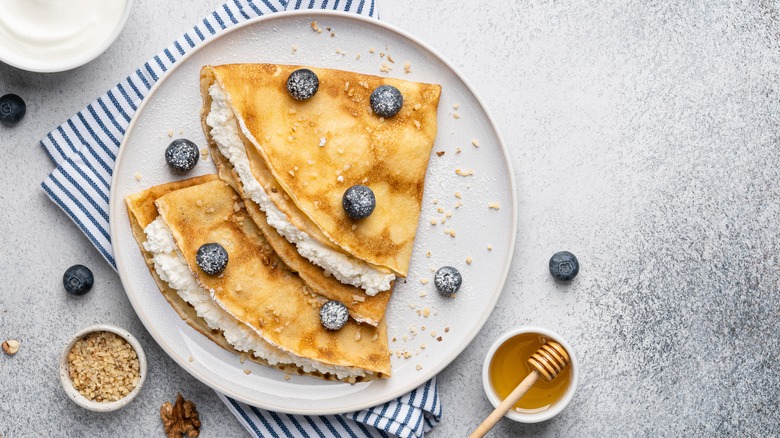How Is Ricotta Salata Different From Regular Ricotta?
Could two kinds of cheese called ricotta really be so different? It turns out that, yes, indeed, they can. When you say "ricotta," most people immediately think of the cheese that goes into a classic lasagna. It's mild, milky, produced widely, and is typically found away from the market's cheese counter, tucked into the refrigerated section by the milk and sour cream. But if your local store sells ricotta salata, this one will be at the cheese counter.
Although they are made from the same exact ingredients, their production methods make fresh ricotta and ricotta salata two different cheeses meant for entirely different uses. Where the former is spreadable and soft, the latter is firm, salty and wouldn't achieve the same effect if you tried to substitute it for its counterpart in lasagna or cannoli. But ricotta salata has its time and place, too, and is a great choice for garnishing anything that needs a salty pop of flavor.
What is regular ricotta?
Fresh ricotta is actually a byproduct of other cheeses. In cheesemaking, solid curds separate from the liquid whey to produce the congealed blocks, but bits of curd are left behind in the whey, and it's these remnants that are used to make ricotta. It can be made from the milk of cows, sheep, goats, or water buffalo. Unlike most cheeses, ricotta isn't aged at all, so it's considered a fresh cheese — one that is full of moisture, is soft and fluffy, but has a little texture.
Fresh ricotta is great for scooping, spreading, or dolloping and adds a creamy flavor to everything it touches, whether those dishes are sweet or savory. It's also quite mild, so it can be flavored in many different ways; in lasagna, ricotta is combined with other cheese and herbs for a savory filling, and in cannoli, the cheese is mixed with sugar, citrus zest, and vanilla. Both are equally scrumptious.
What is ricotta salata?
Fresh ricotta can be made anywhere. Ricotta salata, on the other hand, comes primarily from Sicily and is typically made with sheep's milk. Ricotta salata happens when you take fresh ricotta and salt it, press it to release the moisture, and age it for a minimum of two months. This results in a firm cheese reminiscent of Greek feta or Mexican cotija that is salty, dry, and crumbly in texture. It doesn't melt well, but it's perfect for grating, crumbling, or shaving and using as a garnish.
The aging process it goes through is brief compared to other cheeses that are aged for months or even years, so ricotta salata still has a fresh flavor, yet, but it also has a nutty flavor and mild tang. It's more difficult to find in U.S. supermarkets than fresh ricotta, so if you need a substitute in a recipe, go with another dry, crumbly cheese like queso fresco, cotija, feta, or even pecorino romano. Nothing will match the flavor of ricotta salata exactly, but saltiness and dryness are found in these other cheeses.
What dishes are best with regular ricotta?
It's been established that fresh ricotta cheese can comfortably appear in sweet and savory dishes. You can think of ricotta as a contextual ingredient — neutral-tasting on its own but can be flavored to suit a wide range of dishes. You can spread plain ricotta on toast and crostini and top it with whatever you want, like honey, fruit, crunchy nuts, avocado, and hard-cooked eggs. Ricotta adds a deliciously creamy element to these dishes when it's generously dolloped on top of pizza or pasta.
Ricotta cheese can be used to make cheesecake, pancakes, cookies, blintzes, and even standard cakes. It's commonly flavored and mixed with egg to use as a pasta filling, stuffed into vegetables like squash, used as a base for tomato tarts, whipped into a dip for crackers or veggies, mixed into scrambled eggs, stuffed into chicken breasts, and combined with dough to make fluffy ricotta gnocchi.
What dishes are best with ricotta salata?
The saltiness and dry texture in ricotta salata keep this cheese from being as versatile as its namesake brother, but that doesn't mean you can't find plenty of places to use it. For starters, try replacing feta with ricotta salata. Whether that's in your salads, on your burgers, or mixed in with your watermelon, this cheese will add the kind of salty kick that tastes great in these dishes.
You can also play around with foregoing parmesan and pecorino as your pasta topper of choice and, instead, reaching for ricotta salata. Since it's dry and crumbly, it's ideal for grating over a bowl of fresh pappardelle with tomato sauce or lemon spaghetti. You can cube or slice the cheese for cheese and charcuterie boards or shave it on top of roasted asparagus and zucchini. Don't be afraid to combine your ricotta either; ricotta-stuffed shells in marinara sauce would be delicious with a shower of ricotta salata on top.




